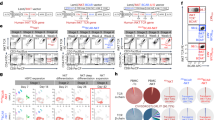Abstract
IMMUNOLOGICAL distinction between ‘self’ and ‘non-self’ is important in maintaining normal homeostasis: a breakdown in this regulation probably results in auto-destructive processes. Recent developments in cellular immunology have shown that the induction of an immune response (sensitisation) involves the recognition of antigen in combination with products of the major histocompatibility complex (MHC)1,2. In this context, it is pertinent to ask whether the induction and maintenance of specific immunological unresponsiveness (tolerance) to foreign antigens is also under genetic control. Contact sensitivity and tolerance to simple chemical compounds (haptens) in mice has provided insight into the complex cellular interactions involved in the unresponsive state3–5. Parenteral injection of the reactive haptens 1-fluoro-2,4-dinitrobenzene (DNFB) or its sulphonate (DNBS) before epicutaneous sensitisation with DNFB results in unresponsiveness3,4. This process seems to be mediated by at least two mechanisms, clonal inhibition and induction of suppressor T cells (Ts)6, both of which can be induced by either DNBS or DNFB coupled in vitro to red blood cells (DNP-RBC). The maximum tolerant state then develops 4–7 d after injection. However, another tolerogen, DNFB coupled in vitro to spleen cells (DNP-SC), produces maximum unresponsiveness immediately. This rapid induction of unresponsiveness was shown to be independent of Ts and thus was referred to as clonal inhibition6. The dichotomy between syngeneic DNP-SC and DNP-RBC in their ability to tolerise immediately was first thought to be due to either different homing characteristics or cell surface components4. With respect to the latter, an intriguing difference between the two tolerogens is the lack of I-region associated (Ia) antigens (of the MHC) on the surface of red blood cells7,8. We have investigated this difference by tolerising mice with DNP-SC depleted of Ia+ cells or with DNP-SC from donors which are I-region incompatible with respect to the recipient animal. The results reported here indicate that the induction of immediate tolerance requires I-region compatibility between the donor of the DNP-SC tolerogen and the recipient.
This is a preview of subscription content, access via your institution
Access options
Subscribe to this journal
Receive 51 print issues and online access
$199.00 per year
only $3.90 per issue
Buy this article
- Purchase on Springer Link
- Instant access to full article PDF
Prices may be subject to local taxes which are calculated during checkout
Similar content being viewed by others
References
Thomas, D. W. & Shevach, E. M. J. Immun. 121, 1152–1156 (1978).
Rosenthal, A. S. & Shevach, E. M. J. exp. Med. 138, 1194–1212 (1973).
Claman, H. N., Miller, S. D. & Moorhead, J. W. Cold Spring Harb. Symp. quant. Biol. 41, 105–111 (1977).
Miller, S. D. & Claman, H. N. J. Immun. 117, 1519–1526 (1976).
Asherson, G. L. & Zembala, M. Proc. R. Soc. 187, 329–348 (1974).
Miller, S. D., Sy, M.-S. & Claman, H. N., J. Immun. 7, 165–170 (1977).
Fish, F. Transplantation 22, 551–558 (1976).
Staines, N. A., Guy, K. & Davies, D. A. L. Transplantation 18, 192–195 (1974).
Davidson, W. F. & Parish, C. R. J. immun. Meth. 7, 291–300 (1975).
Miller, S. D., Sy, M.-S. & Claman, H. N. J. exp. Med. 145, 1071–1076 (1977).
Miller, J. F. A. P. et al. Proc. natn. Acad. Sci. U.S.A. 72, 5095–5098 (1975).
Katz, D. H. et al. J. exp. Med. 141, 263–268 (1975).
Zinkernagel, R. M. & Doherty, P. C. J. exp. Med. 141, 1427–1436 (1975).
Shearer, G. M., J. Immun. 4, 527–533 (1974).
Bretscher, P. & Cohn, M. Science 169, 1010–1042 (1970).
Forman, J. et al. J. Immun. 118, 797–802 (1977).
Clement, L. T. et al. Nature 274, 592–594 (1978).
Author information
Authors and Affiliations
Rights and permissions
About this article
Cite this article
CONLON, P., MOORHEAD, J. & CLAMAN, H. Efficient induction of immediate tolerance to contact sensitivity by hapten-modified spleen cells requires Ia+ cells compatible with recipient. Nature 278, 257–259 (1979). https://doi.org/10.1038/278257a0
Received:
Accepted:
Issue Date:
DOI: https://doi.org/10.1038/278257a0
This article is cited by
-
Accessory cell presentation of hapten-modified self
Survey of Immunologic Research (1985)
-
Carbohydrate structure in tumor immunity
Cancer and Metastasis Review (1985)
-
H-2-restriction and Ia-dependence of the efficient immune recognition of minor histocompatibility antigens in vivo
Immunogenetics (1979)
Comments
By submitting a comment you agree to abide by our Terms and Community Guidelines. If you find something abusive or that does not comply with our terms or guidelines please flag it as inappropriate.



